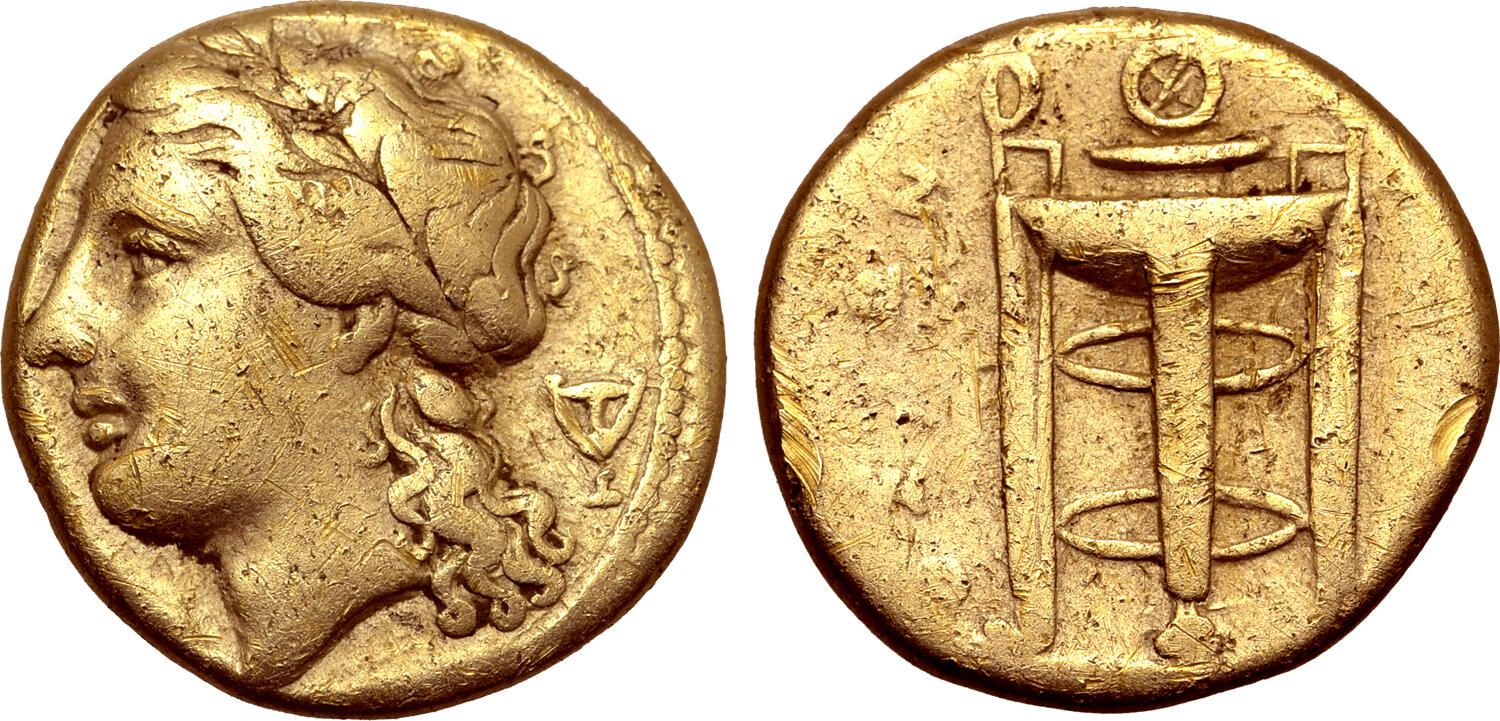Syracuse (Agathocles), electrum, 50 litrai (Apollo/tripod) (310-305 BCE)
From SILVER
310 BCE - 305 BCE Electrum 25,205 kg
Description
| ObverseInscription or printing placed on the obverse.: | Laureate head of Apollo to left, kantharos behind |
| ReverseInscription or printing placed on the reverse.: | ΣΥΡΑΚΟΣΙΩΝ (Greek).Ornate tripod-lebes |
Mint and issuing power
| MintIdentifies the place of manufacture or issue of a numismatic object.: | Syracuse | Ancient regionAncient region.: | Sicily | Modern countryModern country: Italy | AuthorityIdentifies the issuing power. The authority can be "pretended" when the name or the portrait of X is on the coin but he/she was not the issuing power. It can also be "uncertain" when there is no mention of X on the coin but he/she was the issuing power according to the historical sources: | Agathocles of Syracuse (tyrant of Syracuse in 317-289 BC and self-styled king of Sicily in 304-289 BC) |
Chronology
| FromIdentifies the initial date in a range assigned in a numismatic context. | 310 BCE | toIdentifies the final date in a range assigned in a numismatic context.. | 305 BCE | PeriodTime period of the numismatic object.: Hellenistic 323-30 BC |
Physical description
| MetalThe physical material (usually metal) from which an object is made.: | Electrum http://nomisma.org/id/el | Median weightMedian of the weights of numismatic objects (in grams). in grams | 3.55 | DenominationTerm indicating the value of a numismatic object. Examples: tetradrachm, chalkous, denarius.: | 50 litra, half stater | StandardStandard.: |
Image

H 42 - Syracuse, electrum, 50 litrai, 310-305 BC.jpg [1]
References
| Die study referencePublication of the study: | Jenkins 19681Jenkins 1968, p. 145-162, p. 14-15. | ||
| Coin series referenceReference to coin series study: | Sear I2Sear I, n° 957, RQEMH3RQEMH, n° 42, HGC 24HGC 2, n° 1294 | ||
| Coin series web referenceCoin series web references: | |||
Obverse dies distribution
| FrequencyFrequency of specimen in distribution. ᵖ | Number of obversesNumber of obverse dies. ᵖ (o) | % (o) | Number of coinsNumber of coins. (n) | % (n) | Die nameName(s) of the die(s). |
| 1 | 13 | 40.63 | 13 | 8.07 | 2;3;10;15;19;20;21;22;25;29;30;31;32 |
| 2 | 5 | 15.63 | 10 | 6.21 | 16;17;23;27;28 |
| 3 | 2 | 6.25 | 6 | 3.73 | 24;26 |
| 5 | 1 | 3.13 | 5 | 3.11 | 9 |
| 6 | 1 | 3.13 | 6 | 3.73 | 18 |
| 7 | 2 | 6.25 | 14 | 8.7 | 1;6 |
| 9 | 2 | 6.25 | 18 | 11.18 | 5;11 |
| 12 | 2 | 6.25 | 24 | 14.91 | 4;8 |
| 13 | 1 | 3.13 | 13 | 8.07 | 12 |
| 14 | 1 | 3.13 | 14 | 8.7 | 13 |
| 15 | 1 | 3.13 | 15 | 9.32 | 14 |
| 23 | 1 | 3.13 | 23 | 14.29 | 7 |
| Total | 32 of 32 | 100.04 | 161 of 161 | 100.02 |
Reverse dies distribution
no distribution is available
Quantification
| Number of obversesNumber of obverse dies. ᵖ (o) | 32 | Number of singletons (o1)The number of singleton coins. ᵖ | 13 |
| Number of reverse diesNumber of reverse dies. (r) | 44 | Number of coinsNumber of coins. (n) | 161 |
| Coins per obverse dieNumber of coins per obverse die. (n/o) | 5.03 | Coins per reverse dieNumber of coins per reverse die. (n/r) | 3.66 |
| Reverse per obverse ratioRatio of obverse dies divided by reverse dies. (r/o) | 1.38 | Percentage of singletons (o1)number of coins (n) divided by the number of singletons (o1) ᵖ | 40.63 % |
| Original number of dies (O) (Carter 1983 formula)The estimation of the number of coins according to Carter 1983 ᵖ | 35.5 | Coins struck if 20,000 as average productivity per dieCoins made if the average productivity for obverses (according to Carter) is 20,000. ᵖ | 710,000 |
| Original number of dies (O) (Esty 2011 formula)The estimation of the number of coins according to the singleton formula in Esty 2011 ᵖ (O) | 39.94 | Survival rate if 20,000 as average productivity per dieSurvival rate if average productivity is 20,000. ᵖ | 0.00023 |
| Coverage (o = % of O) (Esty 1984 formula)Esty 1984 - coverage (% of O) ᵖ (o = % of O) | 91.93% | Die productivity if survival rate 1/2,000Average productivity if survival rate is 1/2,000. ᵖ | 9,070.42 |
| Weight of silver (in kg) if 20,000 coins per die (O = Carter formula)Carter 1983 * Median weight * 20000 (*10 if gold or electrum) ᵖ | 25,205 kg <br /> 25,205 kg | Die productivity if survival rate 1/5,000Average productivity if survival rate is 1/5,000. ᵖ | 22,676.06 |
Remarks
Likely military
References
- ^ Jenkins, Gilbert Kenneth (1968), "Electrum Coinage at Syracuse", Essays in Greek Coinage Presented to Stanley Robinson, Oxford, 1968, p. 145-162, p. 14-15.
- ^ Sear, David R. (1978), Greek coins and their values. Vol. I, Europe, London, xl, 316 p.
- ^ Callataÿ, François de (1997), Recueil quantitatif des émissions monétaires hellénistiques, Numismatique Romaine, Wetteren, X + 341 p.
- ^ Hoover, Oliver D. (2012), The Handbook of Greek Coinage Series. 2. Handbook of the Coins of Sicily (Including Lipara). Civic, Royal, Siculo-Punic, and Romano-Sicilian Issues. Sixth to First Centuries BC, Lancaster-London, 489 p.